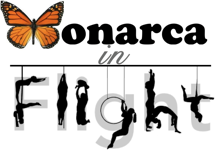Spotlight on: The importance of cross-training
Hello, Monarca! Today I want to talk about cross-training. Cross-training refers to training something that isn’t your main passion but will help you in your main passion. So if your passion is aerials (and I’m gonna go out on a limb here and assume it is), it would be something that’s not aerial but will help you on your aerial journey.
I can hear what you’re thinking: “But won’t just doing more aerials help me on my aerial journey?” And it will… up to a point. Using the same muscles repeatedly will make them stronger. However, using those muscles exclusively, or only using them the same way all the time, puts you at risk of overuse injuries, which are no fun at all and will ground you just as effectively as more precipitous injuries.
For example, in aerials we do a lot of pulling. Like, a LOT of pulling. So our “pull” muscles get really strong. But the muscles that aren’t involved in pulling don’t have much to do, so if we don’t find another way to work them, they get weak. And then, after a while, we can’t access those muscles as easily, and we become imbalanced. The muscles we’ve been exclusively strengthening can’t do everything we need them to do (or at least they shouldn’t), and the other muscles have been neglected, so our bodies can’t function effectively, and we start to break down, and it hurts. Ask your teachers – I can almost guarantee we’ve all experienced it. So we need to find ways to work those under-utilized muscles so they’re still available to us.
Cross-training for aerials will ideally involve using muscles that we don’t use for aerials, as well as using the muscles we do use for aerials but in a different way. There are a lot of ways we can cross-train that will directly and indirectly support us in aerials:
- Cardio: Cardio is great for cross-training, because it helps you find more capacity in your lungs, which will help you stay in the air longer. And who doesn’t want that? Running, dancing, HIIT drills – all those are great.
- Handstands: Remember how I said we use our “pull” muscles a lot? In a handstand, you use a lot of the same muscles, but instead of pulling, you’re pushing. Which is a great way to counter the stuff you do in aerials.
- Pilates/ Gyrotonic/ Yoga: All of these can be great for building more body awareness, finding the connection between your movement and your breath, and building general mobility and strength in a balanced way.
- Flexibility/ Contortion: Same as above. Flexibility training is a lot of active, end-range strengthening, which you won’t get in your general aerial classes.
- Strength training/ Weightlifting: We make a lot of jokes about “the Muggle gym,” but strength training is a great way to hit a lot of muscles that we don’t work in aerial classes. And it might even help you with flexibility, because your flexibility can be hindered by muscle weakness. Wild, right? Bodies are weird.
So, what should you be doing for cross-training? All of the above! Kthxbye!
…I kid. Unless you are training professionally, there are not enough hours in the day to do all the things you “should” do. So my advice is thus: pick a thing that you like to do, that is not aerials, and do that a couple times a week. You like Zumba? Fantastic, do that. Yoga is your jam? Go to those classes. You already do handstands 4 times a week and actually need cross-training for that? Don’t stop, but maybe consider a rest day.
Keep on trucking, you fabulous beasts, you.
-Hilary Eckberg

